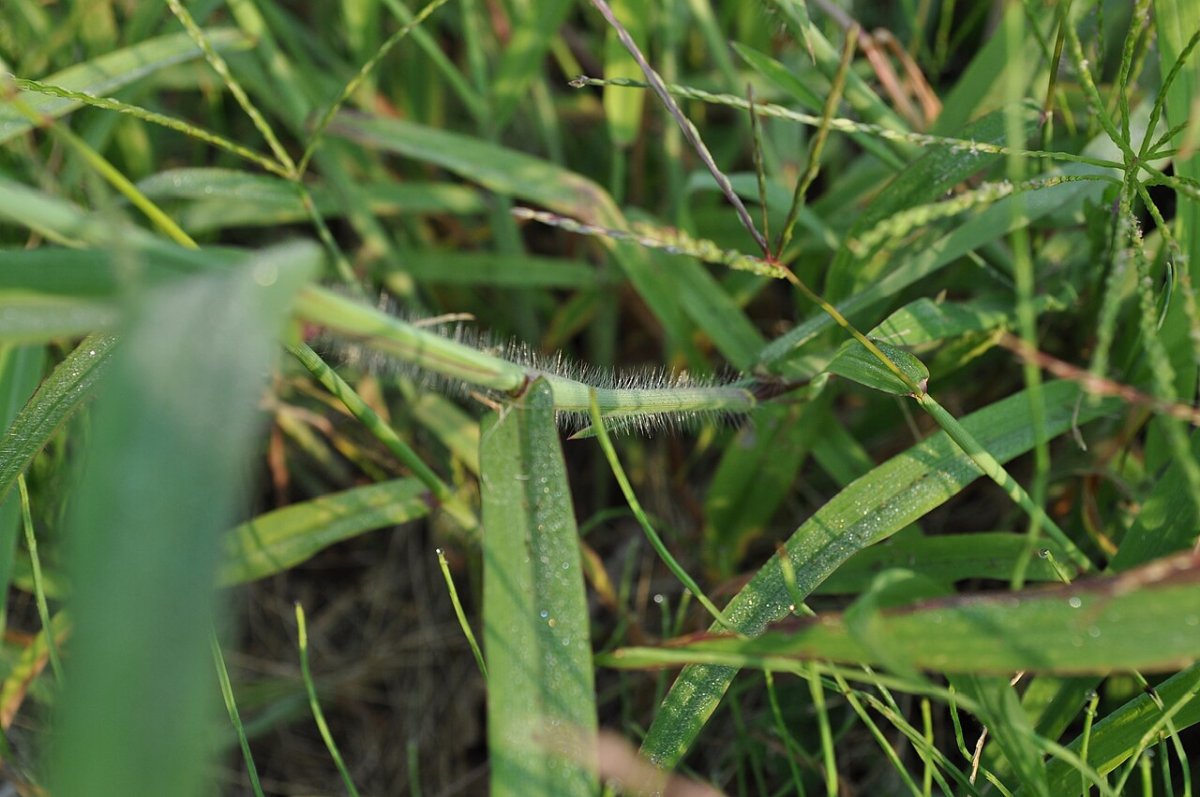
Feeling a bit unsure about when and how to apply crabgrass preventer? Let those worries wilt away as we guide you through a weed-free spring. Target a soil temperature of 55 degrees Fahrenheit, apply evenly, and water well.
While it seems easy, pinpointing the perfect soil temperature for crabgrass preventer is the real challenge. From using a trusty soil thermometer to picking the best product, there’s a lot to think about. Here’s all you need to know about stopping crabgrass in its tracks.
When to Apply Crabgrass Preventer
If April showers bring May flowers, what does early spring bring? Well, it’s certainly not weeds if you’re playing your cards right.
Crabgrass Germination and Soil Temperature
The window for fighting crabgrass usually opens between mid-April and early May. Keep in mind, though, that this annual weed has its own germination schedule that varies depending on the yearly weather fluctuations.
The trick is to apply the crabgrass preventer before it begins to pop up. Timing will depend on where you live, but the general rule of thumb is to wait for soil temperatures at about 1 to 2 inches beneath your lawn’s surface to consistently reach 55 to 60 degrees Fahrenheit (not just a one-day heat wave).
Why be so picky with timing? If you spread weed preventer too early or too late, it won’t work well. It could break down before the weeds start sprouting or miss the boat entirely if they’ve already popped up. Plus, this sun-loving weed drops around 150,000 seeds in a season. And even if you pull up the mature plants, some seeds can stay in the soil for up to 3 years, allowing the weed to pop again in the future.
Do you have crabgrass that’s already grown in your backyard? Our article titled “How to Get Rid of Crabgrass in Your Yard” will show you the best ways to tackle those mature pesky weeds.
Determining Optimal Crabgrass Preventer Timing Locally
How do you figure out the elusive crabgrass germination time in your local area? The first factor you need to consider is your geographical location. It’s a good starting point as crabgrass thrives in warm weather and may emerge earlier in southern, warmer climates compared with northern locales.
Here are the typical windows to apply crabgrass preventer:
- Northern states: Early to mid-spring (April-May)
- Southern states: Late winter to early spring (February-March)
- Transition zone: Sometime in between, depending on the local climate
From this perspective, you can narrow down the ideal application time frame by using some clever tools and even indications that nature provides, including:
- Soil Thermometers: Soil thermometers are good devices that can tell you exactly what’s cooking under the grassy surface. Gently push this trusty tool about 1 to 2 inches deep into the soil and wait for the reading to take shape. Most models are pretty user-friendly. Take readings several days in a row and find the average for a better insight on your soil temp trend.
- Online Tools: If soil thermometers aren’t your thing, electronic alternatives like the GDDTracker offer a slicker way to track them down. This tool uses growing degree day (GDD) models to predict when crabgrass is likely to kick off germination in your specific zip code area.
The number you’re aiming for? Approximately 200 GDD, based on a base temperature of 50 degrees Fahrenheit, indicates when this sneaky weed springs to life. Note, though, that most research on the GDDTracker model is based in the Great Lakes regions. So, its reliability has been proven mostly effective, mainly within that specific zone.
- Environmental Indicators: While not so scientific, they’re pretty reliable indicators, too. When forsythia bushes start to bloom, the soil is usually in that magic 55 to 60 degrees Fahrenheit range. The flowering of other landscape plants like star magnolia or pear trees can signal that it’s herbicide time as well.
How to Apply Crabgrass Preventer
Now that you know when to roll up your sleeves, let’s tackle the ‘how.’ Applying crabgrass preventer is a pretty straightforward process, but you do have to take care not to miss any spots. You’re creating an anti-crabgrass force field across your lawn, and the smallest gap could be an opening for this tenacious weed.
Step 1: Choose Your Crabgrass Preventer
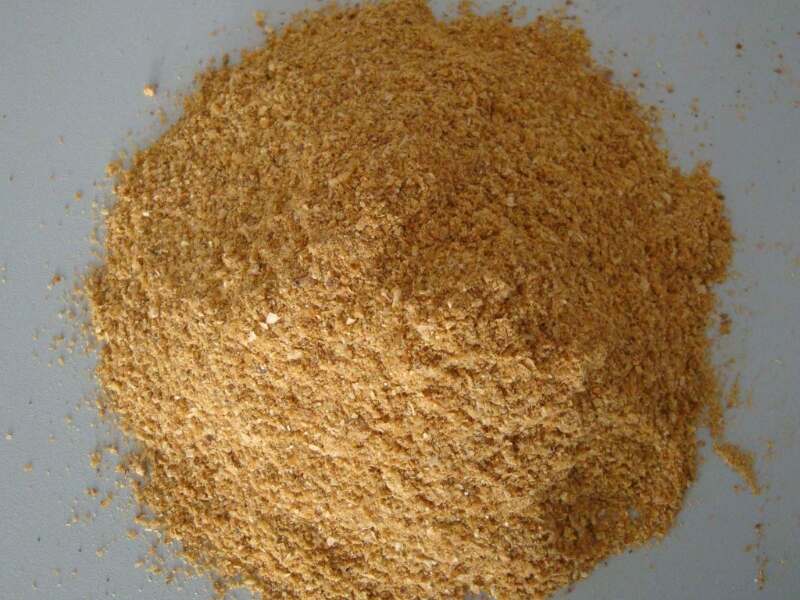
Crabgrass preventers, also known as pre-emergent herbicides, work by inhibiting the growth of weed seeds. You can get them as granules or liquid sprays. Some even combine an early-season fertilizer for a two-for-one garden solution.
Just remember: Pre-emergent herbicides don’t differentiate between weed seeds and desirable grass seeds, so if you’re planning on overseeding your lawn, opt for a product specifically labeled as safe for new grass.
Some popular crabgrass preventer options known for their effectiveness are:
- Pendimethalin: It is a powerful herbicide with a bright orange-yellow hue. You’ll find it in both granule and liquid form, ready to tackle pesky weeds, including crabgrass.
- Dithiopyr: Dithiopyr not only prevents crabgrass and other broadleaf weeds but also offers early post-emergent control on young crabgrass up to the 3-leaf stage. For best results, apply once in early spring and again 6 to 8 weeks later.
- Prodiamine: It is your best bet for long-lasting pre-emergent herbicides. With just one spring application, you have all-season control over crabgrass. Products with prodiamine are usually available in a water-dispersible granule mixed and applied as a spray. This allows for more precise application, especially in trickier areas like flower beds or along edges.
- Mesotrione: It is a selective herbicide that stops crabgrass and other weeds but leaves your new grass seedlings unharmed when used as instructed.
- Corn Gluten: If you’d rather avoid chemicals, there’s a greener option. Corn gluten meal is an organic way of stopping crabgrass seeds from sprouting. Remember, though, it’s not as effective as synthetic versions, and you’ll need to use more of it, which might overnitrogenize your lawn. (Here is our guide on Corn Gluten Meal: All Natural Weed and Feed?)
Trying to figure out the best pre-emergent herbicide for your lawn? Take a peek at our review, ‘8 Best Pre-Emergent Herbicides for Lawns.’ We’ve got the lowdown to help you choose with ease.
Step 2: Spread the Crabgrass Preventer
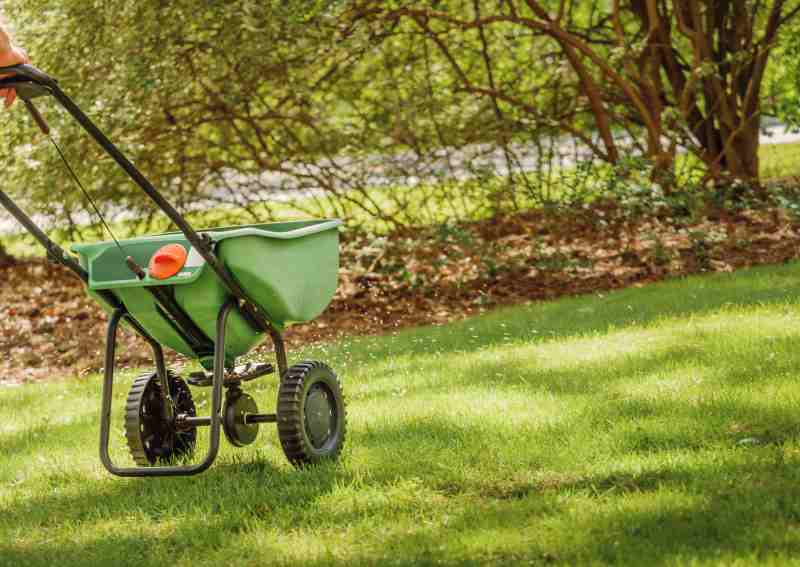
Applying granular crabgrass preventers is quite simple when you’ve got a broadcast or rotary in hand. These tools ensure the even coverage of the preventer across your lawn.
Here’s how to go about it:
- First, set your spreader rate. You’ll need to follow the instructions on the product label specific to your particular model.
- Next, apply it in two separate passes – think of it as crossing a ‘t.’ Making perpendicular passes means you are less likely to miss any patches and get an overall more even distribution.
- Have you got a few stray granules on driveways or sidewalks? Simply sweep them back onto the lawn. This helps avoid unsightly stains and unwanted runoff.
Pro tip: For granular herbicides, the foliage should be wet from dew or light irrigation right before application. This allows the granules to stick to the leaves.
How to Spray Liquid Preventer
The application process is slightly different if you’ve opted for a liquid preventer. Handheld or backpack sprayers work best and ensure accuracy as well.
Follow these steps:
- Mix the concentrated product with water in the sprayer according to label directions.
- Then, apply the spray in slow, even passes across your lawn. As with granular versions, aim to make two perpendicular passes to guarantee thorough coverage. Give special attention to edges where crabgrass often emerges, including driveways, sidewalks, and fence lines.
- Avoid spraying when it’s windy outside. The wind could move the spray to places where it shouldn’t be.
- After you’re done, clean out the sprayer properly. Leftover preventers can accidentally harm your plants later on.
*Note: For liquid herbicides, the leaves and soil should be dry at the time of application
Step 3: Water After Application
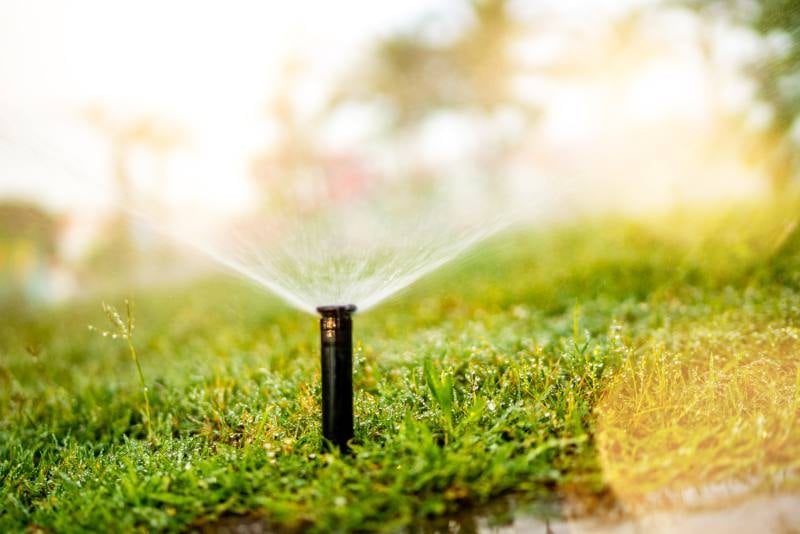
Most crabgrass preventers need a gentle nudge to settle in. A light watering, about one-quarter to one-half inches, or a rain shower soon after you spread them does the trick.
This subtle sprinkle serves a dual purpose: it activates the herbicide and gently nudges it towards the soil surface, right where those weed seeds are twiddling their tiny roots.
Here are some pro tips to ensure you water just right:
- Dodge the Downpour: If a heavy rainstorm is looming, hold off on applying the crabgrass preventer. Going ahead could lead to most of it being washed away before it’s had a chance to activate and set up its protective barrier in your lawn.
- Have Patience With Your Sprinklers: Wait for about 24 hours post-application before running your sprinkler. This gives the herbicide a chance to set in real nice. But don’t snooze on this longer than two days – crabgrass preventers should be watered into the soil within the next 10 to 14 days.
Step 4: Mind the Soil
Aeration, dethatching, and other soil-disturbing activities are a big no-no following crabgrass preventer application. The chemical barrier formed by weed preventers can be compromised if you go around disturbing the soil post-application. Generally, it’s best to wait at least two months after applying the preventer to take on these tasks.
Step 5: Reapply Crabgrass Preventer (If necessary)
Going for round two? Some short-residual products like dithiopyr might need a second application after 6 or 8 weeks, particularly if your lawn has a history of severe crabgrass attacks. However, others, like Prodiamine, provide all-season control with just one springtime application. Always stick to its label instructions no matter what product you decide on.
Looking to tackle pesky weeds in your yard besides crabgrass and not sure where to start? Check out our full guide, Weed Control in Your Yard. We’ve got you covered with tips and tricks that go beyond pre-emergent herbicides.
Step 6: Follow Up With Proper Lawn Care
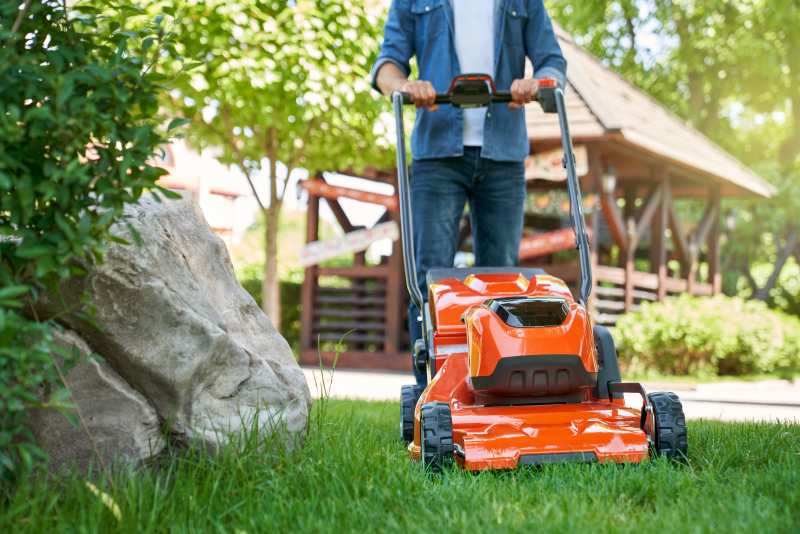
Applying crabgrass preventer isn’t a stand-alone task in lawn care. Think of it as a team effort. By mowing your grass the right way, giving it enough water, and feeding it with the necessary nutrients, you help make your lawn strong and thick.
A dense turf shades the soil, making it harder for crabgrass seeds to germinate. Plus, lawns fed properly crowd out weeds and create a healthy and robust grass that can compete effectively with weeds. This strengthens your lawn’s natural defenses making pre-emergent herbicides even more effective.
Here’s how to harmonize crabgrass prevention with your other lawn care sessions:
- Mowing: The correct grass height means more shade on the soil surface and less room for crabgrass seeds to sprout. Cool-season grasses thrive best when kept between 2.5 to 3.0 inches tall, while warm-season varieties typically flourish at heights of 1 to 2 inches.
For more mowing tips, visit our guide on how to mow the right way.
- Fertilize Thoughtfully: Your lawn needs enough nutrients to be healthy and block weeds, but too much can make it weak and help crabgrass grow.
So, test your soil before applying fertilizer to tailor-fit nutrient levels and enforce weed defenses. Grab a slow-release one so it gets nutrients little by little. (Here is our guide on How to Fertilize Your Lawn.)
- Aeration (when the time is right): Aerating your lawn helps it breathe and stay healthy. It’s good to do this in the fall or spring. Just a heads up: if you used a crabgrass blocker, hold off on aerating for two months.
- Dethatching (when the time is right): Thatch is like a blanket of old grass on your lawn. A little is okay, but too much stops water and lets pests and weeds move in. If it’s more than half an inch thick, you need to rake it out. But if you’ve used pre-emergent herbicides recently, give it two months before dethatching.
- Irrigation: Water your lawn deep and infrequently, this encourages stronger roots. Aim for 1 to 1.5 inches of water per week, including rainfall, in the early morning hours.
- Raking Leaves: Raking leaves prevent the formation of a “mat” that could smother grass and provide a home for pests. Keep your lawn clean, especially before applying crabgrass preventer.
- Overseeding: Overseeding will have your lawn looking lush and thick, making it more difficult for crabgrass to find a spot. Leave a gap of 6 to 16 weeks (depending on the herbicide) after applying crabgrass preventer.
FAQ About Applying Crabgrass Preventer
Should you put crabgrass killer down before or after rain?
Applying a crabgrass preventer before a light rain can help activate the herbicide and settle it nicely into your lawn. But don’t rush to beat an impending storm. Heavy rains could wash away most of your hard work.
Can I apply crabgrass preventer twice?
Some crabgrass preventer products need a re-application after six to eight weeks, especially if your lawn is prone to chronic crabgrass outbreaks. However, others can offer full-season protection with just one shot. Always follow the directions on the product label for optimal results.
Does crabgrass preventer really work?
If applied correctly and at the right time, crabgrass preventers can effectively stop crabgrass seeds from germinating and taking root in your lawn. It won’t eliminate every single weed seed (that’s nearly impossible,) but it can significantly reduce the number of crabgrass sprouts popping up in your yard.
Weed Out the Trouble: Hire a Pro
Keeping crabgrass at bay requires sound timing and application methods. You must hit just right – when the soil is consistently warm, between 55 and 60 degrees Fahrenheit. If you’d prefer to have an handle it, contact a local lawn care professional to treat the weeds for you.
Main Photo Credit: NY State IPM Program at Cornell University from New York, USA / Wikimedia Commons / CC BY 2.0